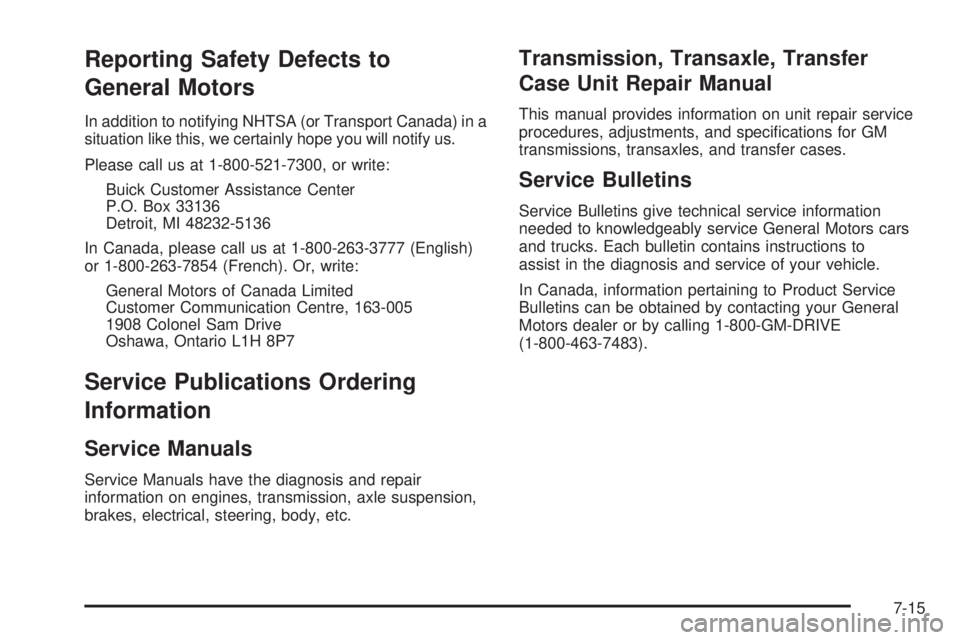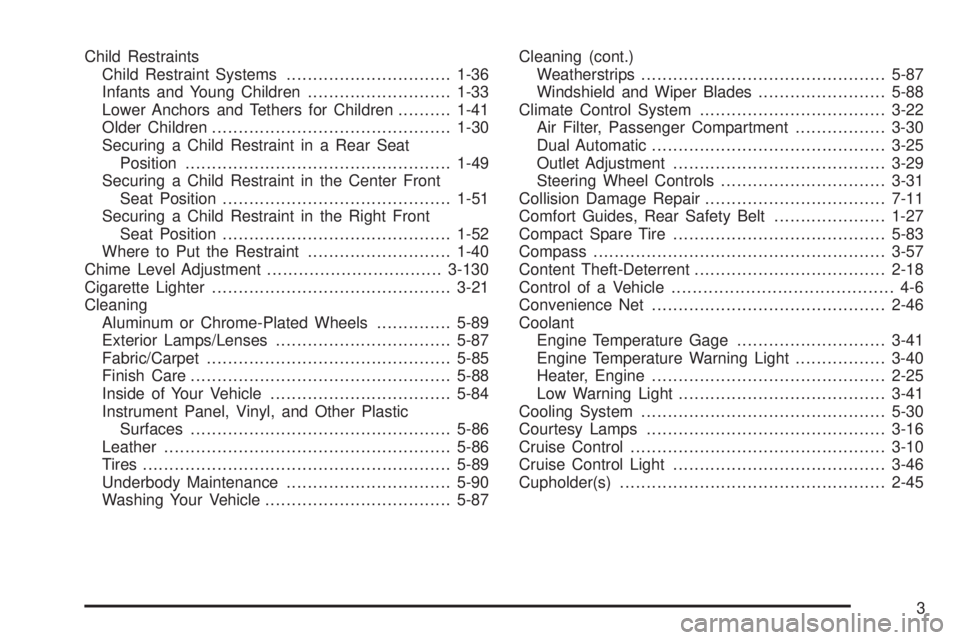2006 BUICK LACROSSE steering
[x] Cancel search: steeringPage 424 of 444

Vehicle Data Collection and Event
Data Recorders
Your vehicle, like other modern motor vehicles, has a
number of sophisticated computer systems that monitor
and control several aspects of the vehicle’s performance.
Your vehicle uses on-board vehicle computers to monitor
emission control components to optimize fuel economy,
to monitor conditions for airbag deployment and, if so
equipped, to provide anti-lock braking and to help the
driver control the vehicle in difficult driving situations.
Some information may be stored during regular
operations to facilitate repair of detected malfunctions;
other information is stored only in a crash event by
computer systems, such as those commonly called event
data recorders (EDR).
In a crash event, computer systems, such as the Airbag
Sensing and Diagnostic Module (SDM) in your vehicle
may record information about the condition of the vehicle
and how it was operated, such as data related to
engine speed, brake application, throttle position, vehicle
speed, safety belt usage, airbag readiness, airbag
performance, and the severity of a collision. If your
vehicle is equipped with StabiliTrak
®, steering
performance, including yaw rate, steering wheel angle,
and lateral acceleration, is also recorded. This
information has been used to improve vehicle crash
performance and may be used to improve crash
performance of future vehicles and driving safety.Unlike the data recorders on many airplanes, these
on-board systems do not record sounds, such as
conversation of vehicle occupants.
To read this information, special equipment is needed
and access to the vehicle or the device that stores
the data is required. GM will not access information
about a crash event or share it with others other than:
with the consent of the vehicle owner or, if the
vehicle is leased, with the consent of the lessee,
in response to an official request of police or similar
government office,
as part of GM’s defense of litigation through the
discovery process, or
as required by law.
In addition, once GM collects or receives data, GM may:
use the data for GM research needs,
make it available for research where appropriate
con�dentiality is to be maintained and need is
shown, or
share summary data which is not tied to a speci�c
vehicle with non-GM organizations for research
purposes.
7-10
Page 429 of 444

Reporting Safety Defects to
General Motors
In addition to notifying NHTSA (or Transport Canada) in a
situation like this, we certainly hope you will notify us.
Please call us at 1-800-521-7300, or write:
Buick Customer Assistance Center
P.O. Box 33136
Detroit, MI 48232-5136
In Canada, please call us at 1-800-263-3777 (English)
or 1-800-263-7854 (French). Or, write:
General Motors of Canada Limited
Customer Communication Centre, 163-005
1908 Colonel Sam Drive
Oshawa, Ontario L1H 8P7
Service Publications Ordering
Information
Service Manuals
Service Manuals have the diagnosis and repair
information on engines, transmission, axle suspension,
brakes, electrical, steering, body, etc.
Transmission, Transaxle, Transfer
Case Unit Repair Manual
This manual provides information on unit repair service
procedures, adjustments, and speci�cations for GM
transmissions, transaxles, and transfer cases.
Service Bulletins
Service Bulletins give technical service information
needed to knowledgeably service General Motors cars
and trucks. Each bulletin contains instructions to
assist in the diagnosis and service of your vehicle.
In Canada, information pertaining to Product Service
Bulletins can be obtained by contacting your General
Motors dealer or by calling 1-800-GM-DRIVE
(1-800-463-7483).
7-15
Page 431 of 444

A
Accessories and Modi�cations............................ 5-3
Accessory Power Outlet(s)...............................3-20
Adding Equipment to Your Airbag-Equipped
Vehicle.......................................................1-70
Additives, Fuel................................................. 5-6
Add-On Electrical Equipment............................5-93
Air Cleaner/Filter, Engine.................................5-20
Air Conditioning......................................3-22, 3-25
Airbag
Passenger Status Indicator...........................3-35
Readiness Light..........................................3-34
Airbag Sensing and Diagnostic Module (SDM)....7-10
Airbag System................................................1-56
Adding Equipment to Your Airbag-Equipped
Vehicle...................................................1-70
How Does an Airbag Restrain?......................1-63
Passenger Sensing System...........................1-65
Servicing Your Airbag-Equipped Vehicle..........1-69
What Makes an Airbag In�ate?......................1-63
What Will You See After an Airbag In�ates?....1-64
When Should an Airbag In�ate?....................1-61
Where Are the Airbags?...............................1-59
Antenna, Backglass.......................................3-129
Antenna, XM™ Satellite Radio Antenna
System.....................................................3-130
Anti-Lock Brake System (ABS)........................... 4-7
Anti-Lock Brake, System Warning Light..............3-39Appearance Care
Aluminum or Chrome-Plated Wheels..............5-89
Care of Safety Belts....................................5-87
Chemical Paint Spotting...............................5-90
Cleaning Exterior Lamps/Lenses....................5-87
Cleaning the Inside of Your Vehicle................5-84
Fabric/Carpet..............................................5-85
Finish Care.................................................5-88
Finish Damage............................................5-90
Instrument Panel, Vinyl, and Other Plastic
Surfaces.................................................5-86
Leather......................................................5-86
Sheet Metal Damage...................................5-90
Tires..........................................................5-89
Underbody Maintenance...............................5-90
Vehicle Care/Appearance Materials................5-91
Washing Your Vehicle...................................5-87
Weatherstrips..............................................5-87
Windshield and Wiper Blades........................5-88
Ashtray(s)......................................................3-21
Audio System(s).............................................3-84
Audio Steering Wheel Controls....................3-126
Backglass Antenna.....................................3-129
Care of Your CD Player..............................3-129
Care of Your CDs......................................3-128
Chime Level Adjustment.............................3-130
Radio with CD............................3-86, 3-90, 3-99
Radio with Six-Disc CD..............................3-113
Setting the Time..........................................3-85
1
Page 433 of 444

Child Restraints
Child Restraint Systems...............................1-36
Infants and Young Children...........................1-33
Lower Anchors and Tethers for Children..........1-41
Older Children.............................................1-30
Securing a Child Restraint in a Rear Seat
Position..................................................1-49
Securing a Child Restraint in the Center Front
Seat Position...........................................1-51
Securing a Child Restraint in the Right Front
Seat Position...........................................1-52
Where to Put the Restraint...........................1-40
Chime Level Adjustment.................................3-130
Cigarette Lighter.............................................3-21
Cleaning
Aluminum or Chrome-Plated Wheels..............5-89
Exterior Lamps/Lenses.................................5-87
Fabric/Carpet..............................................5-85
Finish Care.................................................5-88
Inside of Your Vehicle..................................5-84
Instrument Panel, Vinyl, and Other Plastic
Surfaces.................................................5-86
Leather......................................................5-86
Tires..........................................................5-89
Underbody Maintenance...............................5-90
Washing Your Vehicle...................................5-87Cleaning (cont.)
Weatherstrips..............................................5-87
Windshield and Wiper Blades........................5-88
Climate Control System...................................3-22
Air Filter, Passenger Compartment.................3-30
Dual Automatic............................................3-25
Outlet Adjustment........................................3-29
Steering Wheel Controls...............................3-31
Collision Damage Repair..................................7-11
Comfort Guides, Rear Safety Belt.....................1-27
Compact Spare Tire........................................5-83
Compass.......................................................3-57
Content Theft-Deterrent....................................2-18
Control of a Vehicle.......................................... 4-6
Convenience Net............................................2-46
Coolant
Engine Temperature Gage............................3-41
Engine Temperature Warning Light.................3-40
Heater, Engine............................................2-25
Low Warning Light.......................................3-41
Cooling System..............................................5-30
Courtesy Lamps.............................................3-16
Cruise Control................................................3-10
Cruise Control Light........................................3-46
Cupholder(s)..................................................2-45
3
Page 435 of 444

E
Electrical System
Add-On Equipment......................................5-93
Fuses and Circuit Breakers...........................5-93
Headlamp Wiring.........................................5-93
Instrument Panel Fuse Block.........................5-94
Power Windows and Other Power Options......5-93
Underhood Fuse Block.................................5-95
Windshield Wiper Fuses...............................5-93
Engine
Air Cleaner/Filter.........................................5-20
Battery.......................................................5-42
Change Engine Oil Light...............................3-45
Check and Service Engine Soon Light............3-41
Coolant......................................................5-24
Coolant Heater............................................2-25
Coolant Temperature Gage...........................3-41
Coolant Temperature Warning Light................3-40
Engine Compartment Overview......................5-12
Exhaust.....................................................2-34
Oil .............................................................5-15
Oil Life System...........................................5-18
Overheated Protection Operating Mode...........5-29
Overheating................................................5-27
Reduced Power Light...................................3-46
Starting......................................................2-24
Entry Lighting.................................................3-16Event Data Recorders (EDR)............................7-10
Extender, Safety Belt.......................................1-30
Exterior Lamps...............................................3-13
Exterior Lighting Battery Saver..........................3-15
F
Filter
Engine Air Cleaner......................................5-20
Finish Damage...............................................5-90
Flashers, Hazard Warning.................................. 3-6
Flash-to-Pass................................................... 3-8
Flat Tire........................................................5-72
Flat Tire, Changing.........................................5-73
Flat Tire, Storing.............................................5-82
Fluid
Automatic Transaxle.....................................5-21
Power Steering...........................................5-37
Windshield Washer......................................5-38
Fog Lamps....................................................3-15
Folding Rear Seat............................................ 1-8
Fuel............................................................... 5-5
Additives...................................................... 5-6
California Fuel.............................................. 5-6
Check Gas Cap Light...................................3-49
Filling a Portable Fuel Container....................5-10
Filling Your Tank........................................... 5-8
Fuels in Foreign Countries.............................. 5-7
5
Page 440 of 444

Power
Accessory Outlet(s)......................................3-20
Door Locks.................................................2-11
Electrical System.........................................5-93
Lumbar Controls........................................... 1-3
Reduced Engine Light..................................3-46
Retained Accessory (RAP)............................2-23
Six-Way Seats.............................................. 1-3
Steering Fluid.............................................5-37
Windows....................................................2-17
Pretensioners, Safety Belt................................1-29
Q
Questions and Answers About Safety Belts.........1-14
R
Radiator Pressure Cap....................................5-27
Radios..........................................................3-84
Care of Your CD Player..............................3-129
Care of Your CDs......................................3-128
Radio with CD............................3-86, 3-90, 3-99
Radio with Six-Disc CD..............................3-113
Setting the Time..........................................3-85
Theft-Deterrent..........................................3-126
Understanding Reception............................3-128
Rear Assist Handle Reading Lamps...................3-18Rear Door Security Locks................................2-12
Rear Safety Belt Comfort Guides......................1-27
Rear Seat Passengers, Safety Belts..................1-25
Rearview Mirror, Automatic Dimming..................2-36
Rearview Mirror, Automatic Dimming
with OnStar
®..............................................2-37
Rearview Mirror with OnStar®...........................2-36
Rearview Mirrors.............................................2-36
Reclining Seatbacks.......................................... 1-4
Recommended Fluids and Lubricants.................6-12
Recreational Vehicle Towing.............................4-36
Reduced Engine Power Light............................3-46
Remote Keyless Entry System............................ 2-3
Remote Keyless Entry System, Operation............ 2-4
Removing the Flat Tire and Installing the
Spare Tire..................................................5-76
Removing the Spare Tire and Tools...................5-74
Replacement Bulbs.........................................5-56
Replacement, Windshield.................................5-56
Reporting Safety Defects
Canadian Government..................................7-14
General Motors...........................................7-15
United States Government............................7-14
Restraint System Check
Checking the Restraint Systems....................1-71
Replacing Restraint System Parts After
a Crash..................................................1-72
Retained Accessory Power (RAP)......................2-23
Right Front Passenger Position, Safety Belts......1-23
10
Page 442 of 444

Shifting Into Park (P).......................................2-31
Shifting Out of Park (P)...................................2-33
Shoulder Belt Height Adjuster...........................1-22
Signals, Turn and Lane-Change.......................... 3-8
Spare Tire
Compact....................................................5-83
Installing....................................................5-76
Removing...................................................5-74
Storing.......................................................5-82
Speci�cations, Capacities.................................5-98
Speedometer..................................................3-33
Split Folding Rear Seat..................................... 1-8
StabiliTrak
®System.........................................4-11
Starting Your Engine.......................................2-24
Steering........................................................4-11
Steering Wheel Comfort Controls......................3-31
Steering Wheel Controls, Audio.......................3-126
Steering Wheel, Tilt Wheel................................. 3-6
Storage Areas
Center Console Storage Area........................2-46
Convenience Net.........................................2-46
Cupholder(s)...............................................2-45
Glove Box..................................................2-44
Stuck in Sand, Mud, Ice, or Snow.....................4-30
Sun Visors.....................................................2-18
Sunroof.........................................................2-47
T
Tachometer....................................................3-33
Taillamps
Turn Signal, Sidemarker, Stoplamps, and
Back-Up Lamps.......................................5-54
TCS Warning Light..........................................3-40
Theater Dimming............................................3-17
Theft-Deterrent, Radio....................................3-126
Theft-Deterrent Systems...................................2-18
Content Theft-Deterrent................................2-18
PASS-Key
®III .............................................2-20
PASS-Key®III Operation..............................2-21
Tilt Wheel........................................................ 3-6
Tires.............................................................5-57
Aluminum or Chrome-Plated Wheels,
Cleaning.................................................5-89
Buying New Tires........................................5-66
Chains.......................................................5-72
Changing a Flat Tire....................................5-73
Cleaning....................................................5-89
Compact Spare Tire.....................................5-83
Different Size..............................................5-68
If a Tire Goes Flat.......................................5-72
In�ation - Tire Pressure................................5-63
Inspection and Rotation................................5-64
12